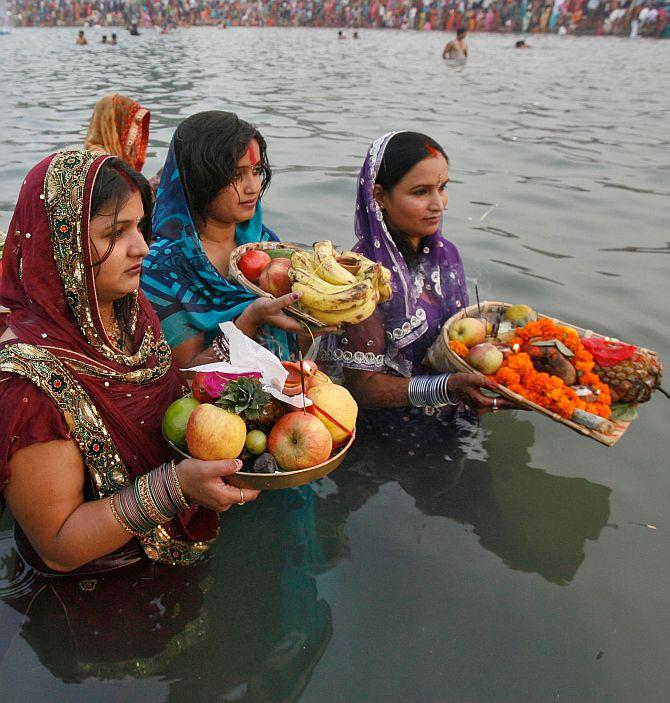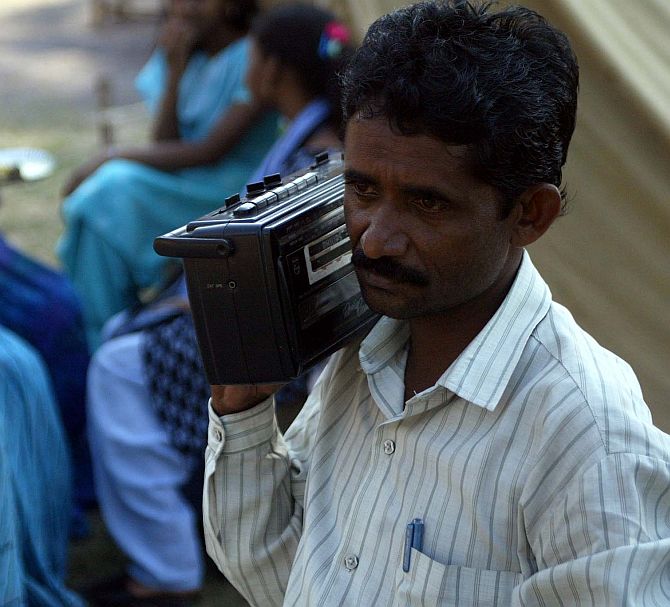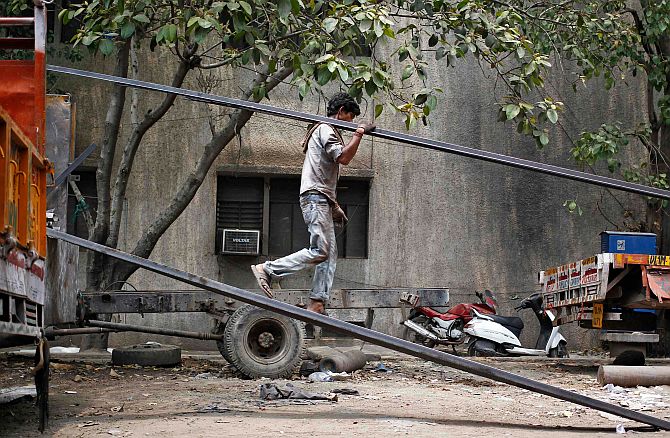Manavi Kapur
There are four million people from Bihar in the capital. Manavi Kapur explores the ecosystem that helps them survive and thrive
Thousands have gathered at the Boat Club, near India Gate in the heart of New Delhi, to wade into its shallow waters and float diyas. The ghats on the banks of the Yamuna are overflowing with humanity. Devotees throng every public water body in the city. Some parks have created special ponds for the occasion.
Delhi Police have issued a traffic advisory. It is the first morning of Chhath when devotees worship the Sun god by offering it water. Bihar’s biggest festival is being celebrated with great fervour in several parts of Delhi. Chief Minister Shiela Dikshit, who is leading the Congress charge for the December 4 elections in the city-state, makes it a point to visit several ghats. Her Bharatiya Janata Party rival, Delhi-born Harsh Vardhan, wishes the people on the occasion in Bhojpuri, which is spoken across parts of Bihar, on radio.
It is a demonstration of the numerical strength of the people of Bihar in the city. Various estimates put their numbers in the city at 4 million; out of a population of 16.8 million, that makes it roughly a quarter. And many of them carry voter identity cards. That’s why BJP has promised that if it comes to power, it will declare Chhath a public holiday. It has fielded four candidates from the community for the elections (out of a total of 70 seats), while the Congress has given tickets to six. The Aam Admi Party, the elephant in the room, has in the fray as many as 15 Poorvanchali candidates.
Quietly, the demographic profile of Delhi is changing, one more time. Till 1857, it was a Muslim city. Life revolved around the decaying Mughal court, courtesans, pigeon fights, food and poetry. When Delhi was recaptured by the British, the Muslims were driven out of the city. The old nobles were replaced by the Hindu merchant castes.
The Muslims returned only after several years. Partition saw a large portion of the Muslim population leaving the city for Pakistan, and a large number of Punjabis, uprooted from their homes across the border, settling down here. That made genteel Delhi loud and assertive. For a long time now, a steady stream of people from Bihar has been coming to Delhi in search of jobs or for education. Today, they are one of the largest migrant groups in the city, but to some extent, still a silent minority.
...
Quietly, they are changing Delhi's profile
Manavi Kapur
Kirari, in northwest Delhi, could be a village straight out of Bihar: all residents are migrants from that state, the place is in dire need of development, the people are very keen to improve their lot, and the divisions of caste and religion are firmly intact.
Bhogendra Mishra, who hails from Madhubani, has been living here with his family for eight years. They have grown roots here. Going back to their village is unthinkable. His son, Pramod, runs a grocery store and his grandchildren attend the local school. They live in a 50-square-yard home. The front of the house serves as the grocery store. A narrow, open drain passes under the entrance to the shop, which Pramod’s wife, with empty water canisters in hand, sidesteps to go and wait for the water tanker. Does he feel his life is better than in Bihar? He shrugs and says: “At least here we can work hard and make a living for ourselves.”
Two lanes down, Jayant Kumar Jha sits outside his grocery store with a newspaper in hand. He works at a call centre for an insurance portal and speaks in fluent English. His eyes light up when he talks of the strides he has taken in life.
Right across, Ashfaq Ahmed from Darbhanga runs a small tailoring unit. He relocated to Delhi in 1984 and now owns a house, out of which he runs his shop. He hopes to marry off his daughter to a boy from Bihar who works in Mumbai. Discrimination haunts Ahmed even in cosmopolitan Delhi. “Whether I am in Delhi or Bihar, the Jhas see me as a Muslim, not a Bihari. One has to ignore these things if one wants to live peacefully.”
Young men, and women, in Bihar don’t have to worry too much before they start for Delhi in search of a job. Most have relatives, close as well as distant, and friends where they can stay, often for months without end, before they find work and a house of their own. This is how Hari Kishore Paswan, a vegetable wholesaler, came to Delhi from Madhepura in Bihar 25 years ago.
It’s 7:20 am, and the entrance to the Azadpur wholesale vegetable market in north Delhi is choked with trucks and tempos. Inside, there are kiosks on either side; one of these belongs to Paswan. He weighs the produce brought in by farmers and traders and sells it onwards to greengrocers. These grocers will then take their stuff to different parts of the city on pushcarts.
Paswan, when he first came to Delhi, stayed with another family from his village. The quarters were cramped but space was made for him. For the next three or four years, he worked as a porter. Then his luck improved and he got this kiosk. Paswan, on a good day, can make up to Rs 500. On bad days, his income can drop to Rs 200.
Paswan’s story shows how Delhi accepts migrants, but also eyes them with suspicion. He took a house on rent many years ago near the Azadpur market, where he stays with his family. Yet, he does not have a voter identity card. That’s because his landlord refuses to testify that Paswan lives at his house -- he is scared that if he does so, Paswan might one day claim right to the property.
That Paswan has been his tenant for over a dozen years doesn’t melt the landlord.
...
Quietly, they are changing Delhi's profile
Manavi Kapur
Vijay Goel, a BJP politician, says that’s why most migrants keep their voter cards handy at all times. “It’s a matter of survival for them,” says he, sitting in his office near Bengali Market.
The ecosystem is especially helpful to those who arrive with a driver’s licence in hand.
A security deposit of as little as Rs 5,000 can get them an auto-rickshaw on rent. Even that money is waived off if one comes through a reference. On an average, each driver earns up to Rs 600 a day.
According to NGO Nyaybhoomi, which fights for the cause of auto-rickshaw drivers, almost three-fourths of the 80,000 or so drivers in the city are from Bihar. Most of them live on the edge: hated by commuters for overcharging, bullied by the police, and burdened by the high cost of living.
Ajit Yadav, one such driver, feels nervous giving his residential address, lest policemen reach his home and heckle him. “Driving an auto-rickshaw is the real challenge,” says he. On being a villain in the eyes of the commuters, he replies: “The rent alone is so high, how am I supposed to make ends meet?” It is perhaps this shared feeling of victimisation that has made Yadav a staunch supporter of the Aam Admi Party. Many like him have agreed to carry the party’s posters on their canvas top free of cost.
The key to finding work in Delhi is the referral system, which depends on a strong network within the community. It works in the security business as well. Thus, of the 500-odd guards on the rolls of Alpha Facility Services as many as two-thirds are from Bihar.
Ajit Jha, a professor of history in Satyawati College and a native of Madhubani district, says that men and women from Bihar are viewed as hardy people who can work in sectors that require hard physical labour. One is security: at Alpha, most guards do eight-hour shifts, 26 days a month, for which they get paid Rs 8,086 per month.
But, cautions Jha, it would be erroneous to club all Biharis as casual workers: “Most labourers are Bihari, but not all Biharis are labourers.”
Their presence, says Jha, can also be seen in business, services, bureaucracy, the media, academia and art.
The Bihar lobby of the all-powerful Indian Administrative Service is strong. There is even a Bihar IAS Wives’ Association, whioch according to CK Mishra, joint secretary in the ministry of small and medium enterprises, is a platform that organises cultural programmes, get-togethers and a bit of social work.
...
Quietly, they are changing Delhi's profile
Manavi Kapur
Could their growing numbers lead to a situation like Mumbai where the Maharashtra Navnirman Sena targeted taxi and auto-rickshaw drivers from Bihar? Their population in Mumbai, after all, is much smaller compared to Delhi. Jha says that it is unlikely to happen because, unlike Mumbai, there is no regional party to whip up hatred amongst locals against migrants. “In a sense, everybody is a migrant here,” says he.
However, Bihari influence on popular culture -- language, food et cetera -- doesn’t match the growing numbers. But the process has started.
Chhatth is getting bigger and bigger in the city. Bhojpuri films are shown in single-screen theatres as well as multiplexes. The National School of Drama and Shri Ram Centre, Delhi's premier destinations for the performing arts, regularly host plays from the region. Food might happen next. Several roadside eateries offer Bihari fare like sattu and litti chokha.
Puja Sahu, who traces her roots to Muzaffarpur in Bihar, has started an upscale Bihari restaurant called Potbelly in the fashionable Shahpur Jat market of South Delhi. Located on a rooftop, the entrance to the cafe is quite easy to miss. But once inside, it looks chic, with comfortable seating, ambient lighting and soft music in the background.
It is 7:30 pm, still early for dinner, and only a few tables are occupied. The fare may be traditional, but is tastefully presented on a platter, keeping urban sensitivities in mind. “Litti,” says Sahu, “originated from lower-income groups and a lot of people felt it was dry from inside since it is roasted. We offer a twist by dipping it in ghee.” A meal for two can cost Rs 1,200 here.
Perhaps because they haven’t fully assimilated in the Delhi mainstream, most Biharis feel the need to stay connected with their folks back home. At the New Delhi Railway Station, the regional lines are clearly drawn. At the Paharganj entry, porters display an exaggerated shudder when asked if they are from Bihar, and point towards Platform 14 from where most trains leave for Bihar. Nearly 20 trains ply between Delhi and various stations in Bihar every week. Apart from this, 15 special trains are pressed into service to accommodate the Diwali and Chhath rush.
It is 11:30 am. On Platform 14, long queues have formed where the general compartments of the Bihar Sampark Kranti are expected to start three hours later.
(The reserved berths got sold out within minutes.) With two Railway Police Force officers minding the queue, the crowds are jittery about whether they’ll get a seat at all. Sukharan, from Madhubani, has been working as a gardener for the last six years at a farmhouse near Chhattarpur. He slogs throughout the year so that he can complete this ritual. “It is worth the trouble,” he says.






article